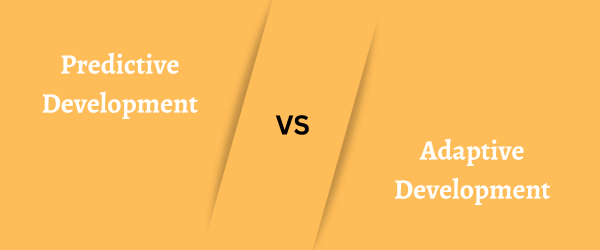Difference between Predictive Development and Adaptive DevelopmentIn this article, we will explore the difference between predictive development and adaptive development, but let us first discuss the meaning of predictive development and adaptive development. 
Predictive DevelopmentPredictive development is a methodology used to create a software development project that focuses on planning and analyzing everything related to the project at a very early stage. The main aspect of this method is that the scope of the project and the deliverables are very well-defined. It predicts the future need of the customers and the risk that may cause the problem, then accordingly designs a strategy to complete the project. If any change is made during the planning of the project, then it can be easily managed, but if the same change is brought later in the project, it may cost more, and the plan needs to be made again from starting and sometimes fail to handle the change. It focuses on completing the project on time without any delay. Predictive development is also called waterfall methodology, which is a sequential method that follows five steps for producing the project, which are analysis, design, implementation, verification, and maintenance. Primarily, predictive development predicts scope, schedule, and cost before executing the project. After that, the project team will put all the effort into making sure that the plan is executed properly. Adaptive DevelopmentAdaptive development is a methodology used to create a software development project that focuses on delivering small pieces of the project, called increments. It follows all the steps that predictive development does, but it delivers small pieces to the customer, takes feedback from the customer, goes back, starts over, and delivers another piece of the project. It adapts to changes as it starts everything again to deliver the next iteration, from planning to providing the next piece to the customer. Adaptive development, also called agile methodology, focuses on providing valuable increments to customers as quickly as possible. It does not make the customer wait until the end of the entire project, but it delivers the project in small pieces, takes customer feedback, and, if required, works on the project again, then delivers the next iteration. Since all the steps and activities like planning, designing, implementing, iteration, and reviewing are repeated many times, the changes can be easily adapted in the next iteration without disturbing the workflow. The key differences between predictive development and adaptive development
Conclusion:You have studied the difference between predictive development and adaptive development in this article. We have concluded that predictive development is the methodology that analyzes and plans the entire project before execution and finally delivers the project to the customer after completing the entire project. On the other hand, we have concluded that adaptive development is the methodology that plans a few iterations and delivers to the customer after each piece is completed. The main difference between predictive development and adaptive development is that predictive development cannot accommodate change easily, and sometimes they fail to handle change. In contrast, adaptive development is more welcoming of changes.
Next TopicDifference Between
|
 For Videos Join Our Youtube Channel: Join Now
For Videos Join Our Youtube Channel: Join Now
Feedback
- Send your Feedback to [email protected]
Help Others, Please Share










